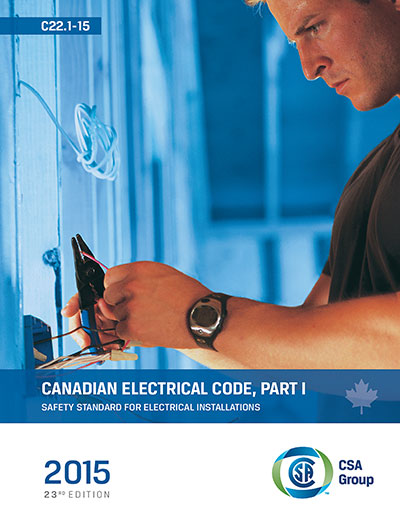The Canadian Electrical Code consists of five parts. Part I covers the installation and maintenance of electrical equipment, Part II is the safety standards for electrical products, and Part III is for outside wiring. Part IV is the objective-based industrial electrical code, and Part VI, the electrical inspection code for existing residential occupancies. This article will focus on Part I amendments.
The Part I committee consists of Part I members, associate members, subcommittee chairs, subcommittee members. A list of these members, complete with affiliation, is located in the front of the Canadian Electrical Code (CE Code). The Part I committee consists of voting members and non-voting (associate members). The voting members consist of a maximum of 44 members, 16 of whom are regulatory authority representatives and the remainder, from the industry.
Appendix C of the CE Code sets out committee and subcommittee structures detailing responsibilities and expectations. Voting members of the CE Code known as “Members” are made up of representatives from regulatory authorities, owners, operators, producers, and general interest. Unlike the representation on the National Electrical Code, IAEI representation on the CE Code is in the general interest category. Associate members of the CE Code include inspection authorities, manufacturers of electrical equipment, employers, employees, consultants, utilities, testing laboratories, underwriters, or fire marshals, primary and secondary industries, National Electrical Code representation, and users. Presently we have 49 IAEI member positions covering each of the 42 CE Code subcommittees.
Six Steps to a Successful Code Change
Step 1. Fill out Annex B in Appendix C and send it to the standards administrator of the Canadian Electrical Code, Part I. Proposals need to include specific wording for a proposed new rule or rule change, the reasons for the request, and background information to support the change.
Step 2. The standards administrator fills out Annex A from Appendix C and sends a copy to the subcommittee chair.
Step 3. The subcommittee chair adds comments and returns the proposal, now referred to as a subject, back to the standards administrator.
Step 4. The standards administrator sends the subject to the subcommittee members for their comments. The subcommittee uses the Canadian Standards Association’s Communities of Interest web site for subcommittee deliberations.
Step 5. After the comments are received from the subcommittee members, the subject is sent back to the subcommittee chair.
The subcommittee chair then decides if the subject is ready to be sent to the Part I Committee for a ballot, or if there is a need for it to be resubmitted to the subcommittee with a reworded proposal or additional rationale. The original submitter may be consulted at this point to ensure the intent of the proposal remains as purposed.
Step 6. When the subcommittee has achieved consensus, the subject is forwarded via the standards administrator to the Part I Committee for a ballot. The Part I Committee meets yearly in June to discuss subjects that received negative ballots. Successful subjects are filed for inclusion in the next edition of the CE Code. Unsuccessful subjects may be returned to the subcommittee or closed. The most important part of the process is the original submission; the more detail and rationale provided the better the success rate.
Being an IAEI Appointee to a Canadian Electrical Code Subcommittee
How many times have you said to yourself? “I don’t understand why that rule reads the way it does. It doesn’t take ________ into account. I think I could have done a better job.”
Every IAEI member has an opportunity to participate in development of the Canadian Electrical Code (CE Code). A very effective way is through the subcommittees. That is where the work is done and key decisions are made.
Participation is very easy — no time consuming meetings. All work is done by correspondence — telephone, letter, e-mail and on-line — with adequate time to respond. If you are a subcommittee member, you are in a special position to suggest changes at the subcommittee level. You have an opportunity to comment on every proposed revision. You are advised of the eventual subcommittee recommendation and CE Code Part I Committee decision.
How does one get involved? Easy — let me know the code section where you have an interest and a brief resume with emphasis on your experience with both the code and the section where you have an interest. You may wish to indicate several sections.
The IAEI already has appointees on all of sections (see Table 1). If you want to be on a particular section subcommittee, you may have to wait. Appendix C Clause C 5.3.3 and C5.3.4 of the CE Code detail limitations on subcommittee composition and numbers of subcommittee members.
If you are interested in participating please send me an e-mail at IAEI@rogers.com

In conclusion, the CE Code is unique in its complete national acceptance as a model installation code. One reason is CSA’s leadership in making it a national consensus standard. Another is the high quality input from hundreds of volunteers. I can’t think of better qualified people to make recommendations on improvements to the code than members of the International Association of Electrical Inspectors. I encourage you to volunteer your knowledge and experience, and look forward to hearing from you.
Steve Douglas
IAEI CE Code, Part I Committee Representative
Tel:(416) 241-8857 ext. 237
Email: IAEI@rogers.com
This article is an update of an article published in September-October 2012 issue of IAEI magazine.














Find Us on Socials